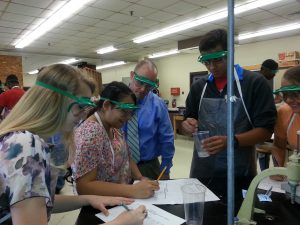Maintaining a Positive Learning Environment
Thomas Mills
Dorchester County Teacher of the Year, 2014-2015
I teach chemistry and physics – two subjects which cause students to become intimidated and lose self-confidence. Many students walk into my classroom on the first day of school believing they will not be successful. Ultimately, most of my students are successful because considerations are made to ensure they have the confidence to meet objectives.Indeed, these considerations should be used in all classes to make sure students believe in themselves. After all, even as adults we avoid those tasks that we don’t think we can do well.
The special considerations that I refer to affect the dialogue a teacher uses to engage a class. A teacher must be a truthfinder – that is, tidbits of truth in a student’s response must be carefully considered and crafted into a correct response through strategic questioning. By finding pieces of truth in responses, students never feel as though they are wrong and will feel more confident when they ultimately arrive at the right answer.
The best way to demonstrate this is through an example of teacher – student dialogue. I will use an example about atomic structure. Just as a refresher for those of you who have not taken chemistry in a long time, the protons and neutrons are located in the nucleus of an atom and the electrons exist around the nucleus.
Teacher: What are the charged particles in the nucleus of an atom called?
Student: Electrons.
Teacher: Electrons are indeed charged particles and they are part of an atom. Try to think back to our studies of the atom. Are the electrons actually in the nucleus?
Student: Oh, that’s right. They orbit around the nucleus. It is the neutrons that are in the nucleus.
Teacher: The neutrons are most certainly located in the nucleus. What did we say that the word neutron sounded like?
Student: Okay, I remember! We said it sounds like neutral. So it’s not the neutrons that are charged – it’s the protons! They are the charged particles in the nucleus.
Teacher: You are exactly right! Well done!
The student would have become discouraged and most likely disengaged if the teacher did not find some truth in the incorrect answer and build upon that truth until the student arrived at the correct answer. Instead, the student gained confidence because the teacher worked to improve his answer until it was exactly right. The teacher never told the student he was wrong in spite of the fact he clearly was wrong. This type of questioning takes practice and requires teachers to think on their feet. However, when done correctly it is a great way to promote a positive learning environment in which students feel comfortable with challenging material. A recent clip on CBS Sunday Morning about criticism stated that our brains are “Velcro for the bad but Teflon for the good.” We must remember this during every lesson that we teach and think like a proton – positively!
